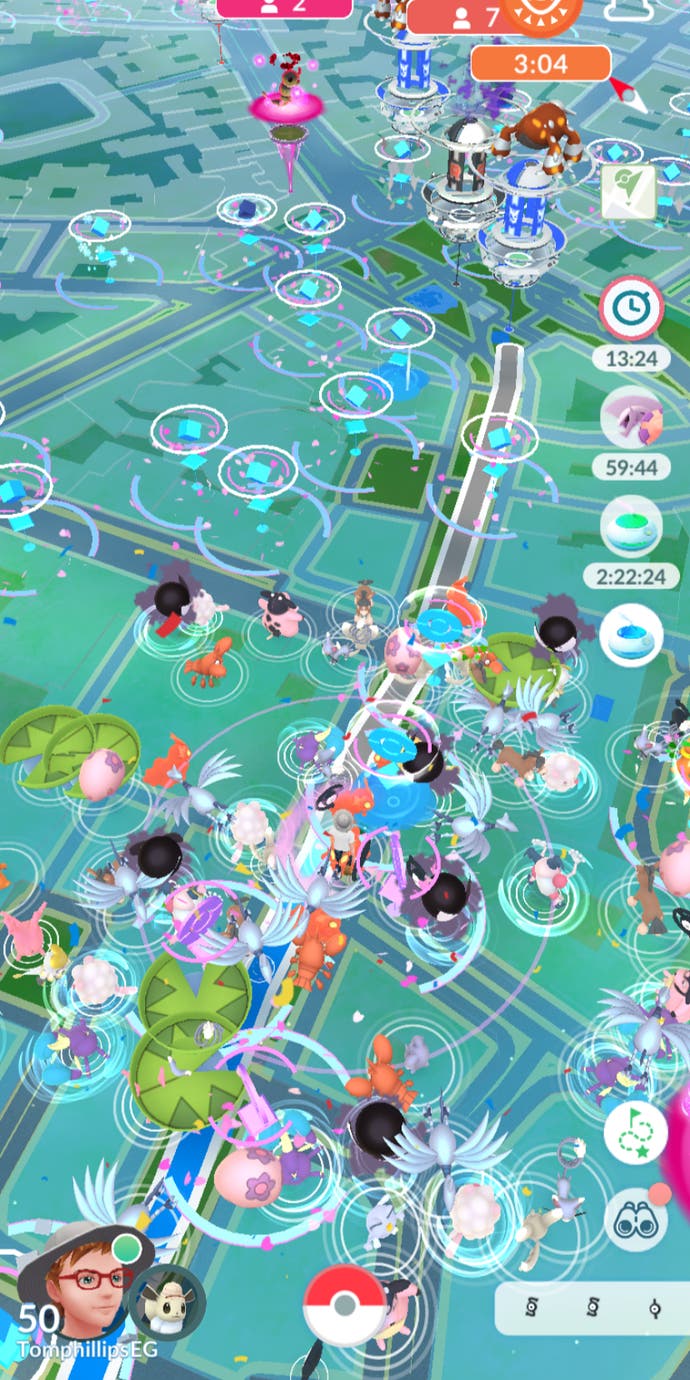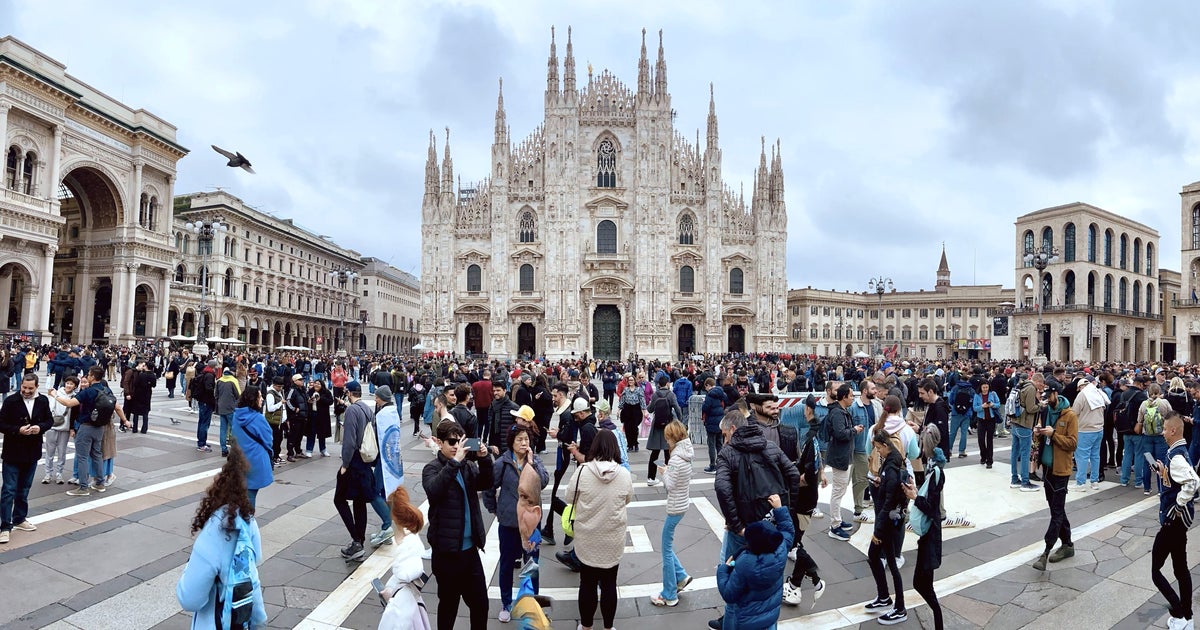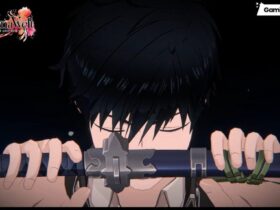Milan’s sunny streets and packed city squares feel a long way away from the corporate boardrooms in which Pokémon Go‘s future was recently decided – where it was agreed the game would be sold as part of a $3.5bn deal to the Saudi-backed Monopoly Go maker Scopely. Among the game’s thriving community, which gathered in Italy’s fashion capital over the weekend for a big City Safari meetup, there was a feeling of business as usual – though plenty of opinions on what might happen next.
The Pokémon Go community, and in particular those who travel long distances to play together, is very switched on. For many players, this game is a way of life, a hobby that connects them with friends and acts as a companion to daily exercise. Recent stats revealed that around half of the game’s regular audience play every day, and do so for an average of 40 minutes. (How many people play? 100 million people logged into Pokémon Go across 2024, with 20 million weekly players.) It wasn’t a surprise, then, that everyone I spoke to across the past weekend in Milan was aware of the game changing hands, with a range of expectations for the result.
Just a few streets over from the city’s glamourous fashion district, where Ferraris crawl down the streets and park up behind gilded ropes, the city’s packed Duomo cathedral square offered a more familiar crowd: thousands of Pokémon Go players milling about, toting backpacks, battery packs and sensible shoes. The weather was glorious – enough to consider breaking out the shorts – though the locals, more conditioned to the sunshine, continued on in padded coats.
Pokémon Go’s City Safari events are a more recent addition to the game’s physical meetup roster, a simpler evolution of the Safari Zone concept – essentially, ‘explore this area and catch as many rare creatures as possible’ – now no longer limited to a particular park. Instead, City Safari gameplay stretches across a far wider area, allowing players to get involved wherever they walk, amidst whatever other bits of sightseeing they might want to do.
I’ve played various Safari Zone events before, and was curious how gameplay would feel without a central park hub. I’ve also written in the past about how the city-based sections of Go Fests have sometimes felt the weaker portion – particularly in capital cities such as London and Berlin, though less so in Madrid – where the atmosphere suffered from players being spread too thin over too wide an area. In Milan, this was not a problem – the city centre felt just the right size and sufficiently able to cope with big pedestrian crowds, particularly between the centre’s castle and cathedral. These areas were constantly full of players plodding about in cardboard Eevee hats, and it was clear the game’s Italian community had come out in force.


Italy has never hosted a big Pokémon Go event before, and there was huge excitement among locals I spoke with that their country had finally been given some of the spotlight. While Milan is situated far in the north of Italy – much easier to get to for those travelling from neighbouring countries – I saw meetups of groups from Rome, Bologna and Naples, posing for photos holding their local community flags. From further afield, players told me they had hopped on trains and planes from Switzerland, France and Germany. A couple of players I met told me they’d travelled from Belgium and the UK, respectively, after being in-game friends for five years, in order to walk the streets of Milan together.
For those who made the journey, the event received a pretty warm reception. Rare spawns such as the alphabet Pokémon Unown were more common here than in recent Go Fests, with a good chance of finding their coveted Shiny versions. The region-exclusive Corsola – usually found lurking around the equator – and the UK-exclusive Mr Mime were also offered, alongside a costumed Eevee wearing a safari hat. The star of the show, though, was the brand-new release of Mudbray, a donkey Pokémon that’s set to only be offered at Safari events for the foreseeable future. It replaces cute goat Pokémon Skiddo, which will finally get a wider release this summer after being a Safari exclusive for several years.

The main gripes I heard about the event were relatively minor. The overlap of a worldwide in-game event for three hours of the first day was an irritation for some, as it temporarily replaced some PokéStop tasks that could otherwise award Safari-exclusive Pokémon. Safari Eevees were strictly limited in number, meaning that when you had found their special PokéStop hiding places, this element of the event no longer had use. Finally, the game had a lack of raids on the event’s first day, and no special raids for the event overall. While none had been advertised, and raiding is not typically the focus of a Safari event, players I spoke with justifiably pointed out that Niantic had been happy to sell an optional $5 raid-focused ticket add-on with nothing out of the ordinary to then use it for.
As for the sale of Pokémon Go itself, opinions were mixed. One player I spoke with, who had helped organise a convoy of cars ferrying players from his Swiss community, said he expected the game would likely feel similar – although only because it was already trending towards increased monetisation from the more regular sale of in-game tickets. Others said it was too early to say what Scopely’s impact might be, while a father travelling with his wife and son from the UK told me he was reassured somewhat by Scopely keeping the Pokémon Go development team intact and together under new ownership. One player told me they were pleased to see the game part ways from Niantic’s mapping-focused mothership (“it can’t get worse” under Scopely, they declared) while others expressed concern the game could receive in-game advertising similar to Monopoly Go – something Niantic has recently attempted to soothe fears about.
Sensitivities to the sale clearly remain and, it seems, are being keenly watched. Simultaneous to the Milan event, Niantic issued an unusually detailed denial and explanation of a recently-datamined code fragment referencing in-game mobile advertising – something that spun players on social media into a panic. (The gist, Niantic said, was that this new snippet was part of a third-party code library update, rather than something new being deployed by its team to insert fresh advertising within Pokémon Go.) “We will not be bringing intrusive in-game ads to Pokémon Go,” is Niantic’s official response. “Not now, not ever.”
From what I saw, most Pokémon Go players seemed to leave Milan happy, flush with new creatures to boast about back home. Several players said they already had tickets to Go Fest, Pokémon Go’s biggest annual meetup, which lands in Paris in three months’ time. By then, Pokémon Go’s sale will likely be completed and any immediate impact more visible. For now – well, give Pokémon players a city square full of their fellow fans, and they’ll come.
This article is based on a visit to Milan, for which Niantic assisted with accomodation.
fbq('init', '560747571485047');
fbq('track', 'PageView'); window.facebookPixelsDone = true;
window.dispatchEvent(new Event('BrockmanFacebookPixelsEnabled')); }
window.addEventListener('BrockmanTargetingCookiesAllowed', appendFacebookPixels);












Leave a Reply